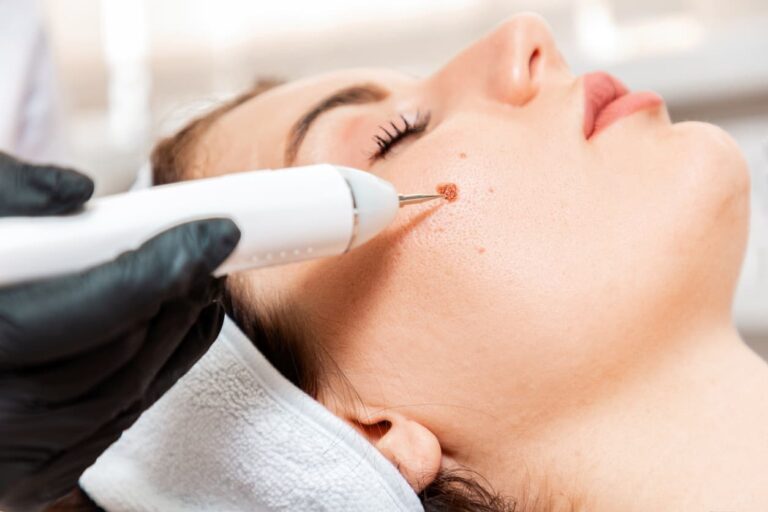February 6, 2023
Moles, also known as nevi, are a common occurrence on the human skin. These dark or light-coloured growths can appear anywhere on the body and may be present from birth or develop later in life. While most moles are harmless (benign), some may be cancerous or have the potential to become cancerous, so it is crucial to have them checked by a dermatologist.
Mole removal is a standard dermatological procedure performed for medical and aesthetic reasons. The process involves removing the mole using one of several techniques, depending on the size, location, and type of mole. Dermatologists are highly trained and qualified medical doctors specializing in diagnosing and treating skin conditions, including moles.
Moles can significantly impact a person’s self-esteem, mainly if they are located in a visible area or are particularly large or noticeable. Some people may feel self-conscious or embarrassed about their moles and go to great lengths to conceal them. This can have a negative impact on their mental health and well-being, which is why many people choose to have their moles removed for aesthetic reasons.
1) Pre-treatment procedures: Before the mole removal treatment, a dermatologist will conduct a thorough evaluation of the mole to determine the best course of action. This may involve a physical examination including the use of a dermatoscope (hand-held magnifying device), a review of the patient’s medical history, and a potential biopsy of the mole if there is a concern about it being cancerous. If the mole is deemed benign, the dermatologist will discuss the patient’s options for removal, including the risks and benefits of each technique.
2) Several types of moles can occur on the skin, including:
a) Congenital nevi: These moles present at birth or appear during the first year of life. They can range from small to large and may be anywhere on the face or body.
b) Acquired nevi: These are moles that develop later in life and are the most common type – they appear anywhere on the face and body and are usually smaller in size.
c) Atypical (dysplastic) nevi: These moles have irregular or asymmetrical shapes, uneven colour, and can stand out compared to other typical moles seen on the patient.
3) Benefits of getting mole removal treatment from a Dermatologist:
While some Medi spas may offer ‘mole removal treatments’, it is recommended to see a dermatologist for this procedure. Dermatologists are the foremost and undisputed top skin experts that exist in medicine, with extensive training and expertise to diagnose and treat skin conditions, including moles. They have access to specialized diagnostic training and equipment and advanced excision techniques, that are unavailable at Medi spas. Dermatologists can provide a more comprehensive skin evaluation to ensure that the mole is not cancerous.
4) What happens during the mole removal procedure?
During the mole removal procedure, local anesthetic is injected into the skin around and over your mole(s), numbing them in preparation for surgery. The use of ice or cold packs may also be considered. Your dermatologist will use a scalpel, surgical blade, laser or other surgical tool to remove the mole. Your mole removal procedure may or may not require small stitches to promote healing.
5) How long does the mole removal procedure take?
The procedure takes about 15 minutes and is done in a doctor’s office or a clinic. Your dermatologist will numb the area with a local anesthetic before removing the mole so there’s no pain during the procedure.
6) How many moles can be removed in one treatment session?
Depending on the size of the mole, how many moles are being removed and where they’re located on your body will determine how long it will take to remove all of them.
7) What can I expect after mole removal surgery?
After mole removal surgery, you will have a bandage on your skin. The bandage will be removed after one to two days, and the stitches will be removed a few days later, as directed by your dermatologist. You may experience some swelling, bruising and mild tenderness at the surgery site for several days following your procedure. Your dermatologist may recommend avoiding sun exposure for a period of time after mole removal surgery to prevent post-inflammatory hyperpigmentation from occurring.
Conclusion
For patients with benign moles causing aesthetic concerns, a dermatologist can offer several options for removal, including laser-directed therapies, surgical excision, shave excision +/- electrodessication. The best technique will depend on the size, location, and type of mole that is desired to be removed. In addition to removing the mole, your dermatologist can also provide advice on how to care for the wound and minimize scarring, which can help improve the patient’s self-esteem and overall quality of life.
For mole removal in Edmonton, visit VIDA Dermatology and be assessed by our Board-Certified Dermatologist to discuss the best mole removal procedure for you.



